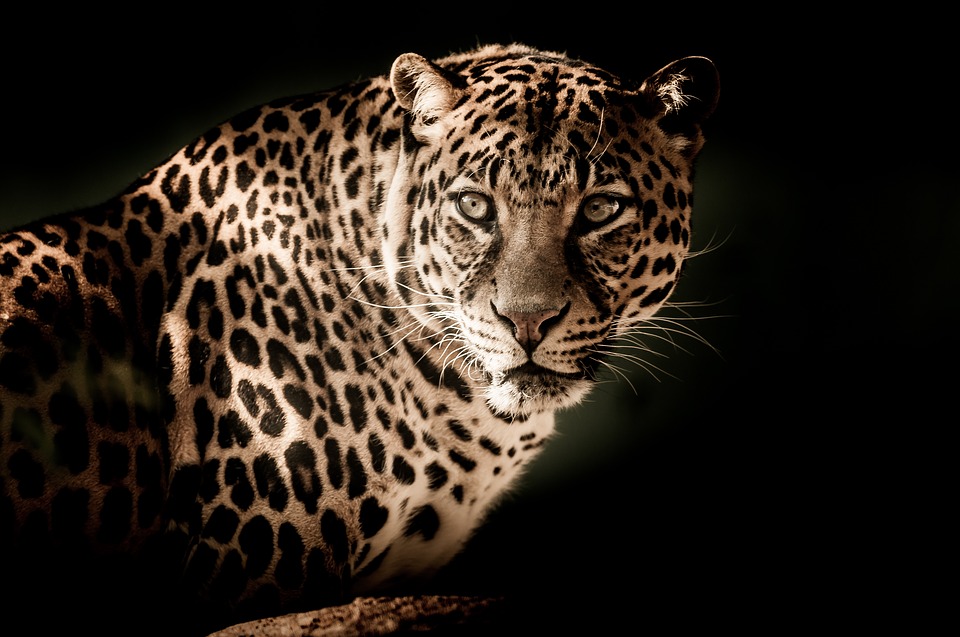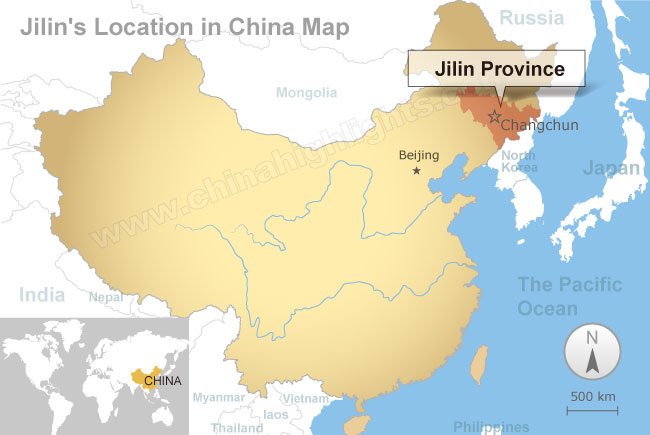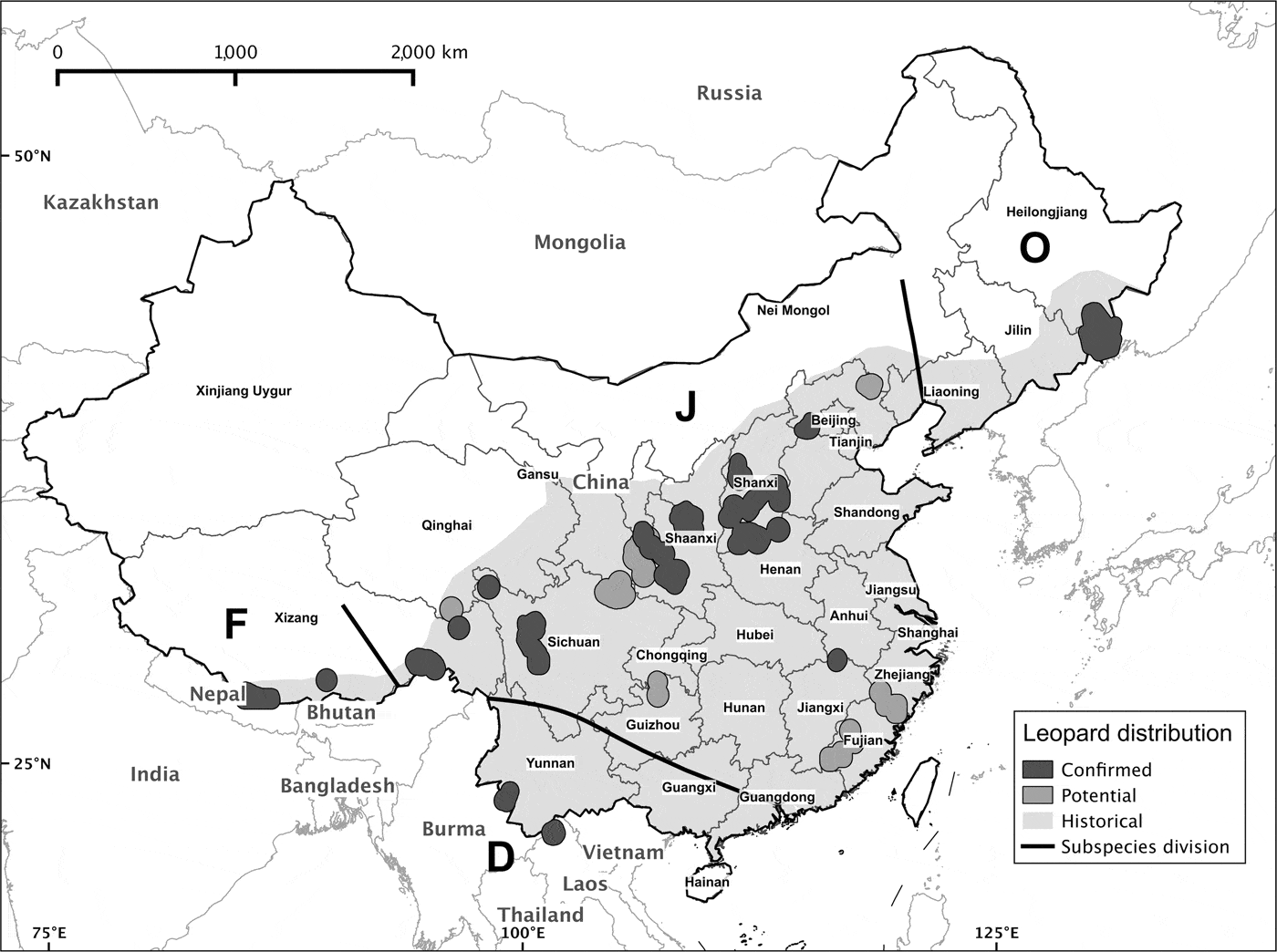
The wilderness in China's Jilin province provides abundant opportunities for Amur leopard habitation. [o]
Several years ago I embraced the cause of the Asiatic common leopard. Today, as a free-lance journalist, I'm headed towards the northeastern region of Jilin in China which, at present, is the leopard’s best hope of survival in China.
Unlike Patagonia, the Russian Altai or Costa Rica, China does not spring to mind as an ecologically-friendly destination. Nor does one relate a large wide-ranging carnivore like Panthera pardus to the most populated country in the world — unless it's to be found cut up in parts for medicinal, decorative or sartorial purposes. Surprisingly, the big cat has survived in this heavily industrialized country — hostage to its vast human population and severe environmental problems. The survival of the leopard in China is a testimony to this cat’s remarkable ability to survive.
The seven hour fast train ride from Beijing to Changchun, capital of Jilin Province, reveals a flat, irresolute landscape, never quite weaned from urban/industrial domination and its spoliation of nature. Agricultural strips alternate with 'brown field' zones. (Brown fields are those unattractive, dishevelled, dirty grassy areas seen usually in suburban areas, in-between the actual city and the countryside — and where there was some kind of industrial activity, or a depot of some sort. Once left alone, the grass grows brown and ugly.) Beyond, in every direction, high-rise housing that is ever in the process of going up casts menacing Mordor-like shadows over the ‘countryside’. It reflects China’s present real-estate boom bolstered by the improved buying power and desire of the Chinese people to acquire private property. However, in this dismal panorama there are signs of on-going change. While whizzing by on the train, I notice the frequency of brown fields in the process of being reforested.
He seemed to embody what I have come to see as China’s capacity to do a quick spin–around from previous policies . . .
In Changchun I am greeted by a frosty wind and a toad-colored fog erasing the outlines of the city: a typical sandstorm that might be coming from any of the regions in North China that are subjected to aeolian desertification. The wind, mixing sand with industrial pollution, fills the air with particulate matter scientifically named PM10 (or if less than 25 micrometers, PM25). The risk of lung damage has become common throughout most of China. The hotel management hands me the type of surgical mask I’ve seen Chinese people wear frequently. Breathing has apparently not become easier since my last visit to the mainland sixteen years ago — during the drive from the airport to Shanghai’s center. I had then found myself gasping for oxygen whether the taxi windows were open or shut.
Yet environmental concern in China has been brought to the fore. Not far from Changchun, in the best-preserved and most extensive forest in China, the government has recently officialized a 15000 kilometer square national park astride the provinces of Heilongjiang and Jilin adjoining Russia and North Korea. The park will primarily benefit the Amur leopard (Panthera pardus orientalis) and the Amur tiger (Panthera tigris altaica), allowing these big cats to circulate freely between Russia and China as double nationals. The public's enthusiasm for wildlife implies the will and wish to preserve the entirety of that wildness and so an international collaboration such as this appears as an ideal solution to increase the size of a protected area. Close juxtaposition to the Russian Land of the Leopard Park greatly improves the chances of survival for the endangered cats, and such joint ecological action between the two countries suggests something of a shared culture, which may contribute to improved overall cross-boundary relations. The area chosen to be the tiger and leopard park, based on ten years of consistent camera–trapping, has confirmed the presence of forty-two leopards, with the gender ratio being seven to eight males for forty females.
A few days earlier, in Beijing, I had met Dr. Feng Limin, Associate Professor at the Beijing Normal University, who is the directing force behind the research and monitoring of leopards in the northeast. With vivacity and driving optimism he seemed to embody what I have come to see as China’s capacity to do a quick spin–around from previous policies, at least when deemed necessary. I derived from him the keen sense that conservation of the Sino-Russian Amur leopard was going to be a success.

"The common leopard has surprisingly survived in this heavily industrialized country..." [o]
Collaboration between Russian and Chinese scientists has become normalized through a yearly workshop during which the more experienced Russians in matters of Amur leopard and tiger research act as guides to the Chinese researchers, who willingly acknowledge their beginner status regarding big cat conservation. Since the end of the 20th century, efforts to increase and stabilize a leopard population in the region have led the Chinese government to take steps to preserve primary forest and return some farmland and grassland to woodland. As a result, forest land has increased by some 165,414 hectares, contributing to the region’s green great wall’ plan against desertification and floods.
Such radical changes in environmental policy — along with the plan to create more national parks throughout the country (two dozen parks) — signify, according to Aimin Wang, director of the Wildlife Conservation Society (WCS)/China, that wildlife conservation has become a priority for the Chinese government. Beyond this focus put on the northeastern leopard population, which is hoped to double in two or three years, the turnaround in policy will benefit other known small leopard populations in China. Dr. Wang admits that though poaching and the manufacture of illicit medicinal products are not entirely eradicated in China, their slowdown has positioned China favorably compared to other Asian countries like Thailand.
Dr. Wei Yao Kong, of the Jilin Provincial Academy of Forestry Science, suggests that the quality of protected areas determines whether conservation will be a success or a failure. Ungulates in China thrive on Korean pine, while wild boar, sika deer and red deer need oak; their ability to prosper ultimately benefits the leopards that prey on them. Other leopard prey, such as the gaur (also called Indian Bison), will have to be reintroduced in China, or officially protected, like the oft-hunted roe deer.
My faithin the efficacy of China’s new environmental measures comes up against Dr. Kong’s more measured and expeditious assessment of the future: he wants things to move faster. The large tiger and leopard park is indeed a great step forward, but only if preservation can be sustained. The necessary funds for the project, secured by way of the real-estate boom, create a yin and yang dilemma where land is preserved in one place, thanks to money earned by wrecking nature elsewhere. Indeed, one can only wonder how, or if — in a country of 1.4 billion people (and inexorably ticking upward) — an enduring solution for wildlife can be found. How long can such a balancing act endure: building on land to shelter a relentlessly growing population guarantee the permanent conservation of land in another part of the country?
Hunchun is 3½ hours away by train from Changchun and the panorama flashing by shows, this time, many seemingly untouched forest patches. Informed that Hunchun was small, I am expecting a village at the fringe of the forest. In fact, it is a fast-growing town of broad avenues inhabited by 200,000 people reliant primarily on its natural resources for income. Still, a feeling of wilderness lingers nearby. Russia and North Korea are, respectively, 20-40 kilometers away. With the Land of the Leopard Park on the Russian side and the unknown of North Korea’s wildlife nearby, the leopard may have a fighting chance here.


Jilin province in China. [o] [o]
Ren Yi, director of WCS/Hunchun, drives me to the Nature Reserve of Hunchun, established in 2001. While he and his colleagues verify the camera traps, I look around at the type of habitat that leopards and tigers may be roaming through at this moment. It is the same kind of Manchurian forest I have seen on the Russian side: well-watered, slim, tight woods, vividly green in this month of May. Sunlight plays a subtle hide-and-seek where one can easily imagine the spotted coat of the Amur leopard invisibly slipping by. Fourteen leopards in a 1000 km square area have been camera-trapped here recently, compared to 8-11 in 2012. The camera traps — typically placed in pairs, facing each other, at 45-50 centimeters above ground, every 3-4 km on average — have captured no leopard this time. Perhaps this edge of the forest, regularly frequented by Hunchun locals, is not a leopard’s favorite haunt.
Russian field scientists have taught their Chinese colleagues one of their tricks to get leopards in the camera frame. A piece of aluminum foil is left on a log placed in front of the camera (leopards like to step on logs), to draw the cat’s attention. The cat investigates the shiny object on the log and is photo-trapped. The anecdote encourages me to draw from my pocket a bottle of a famous men’s cologne, reportedly used by feline specialists to attract big cats into view when in the field. I spray it on neighboring tree trunks under the doubtful eye of my companions. But previous use on captive tigers and leopards has proved it to be irresistible.
Is it utopian to hope that such idiosyncratic practices based on close animal observation foretell a new quality of relationship with wildlife — one closer and more attentive to a wild animal’s individuality? Another consideration — which, increasingly, must be concomitant with nature conservation — is human population size. How many people and how many wild animals can satisfactorily coexist, and for how long? Despite China’s outlawing of poaching, Ren Yi informs me that people gather pine nuts in the forest (thus competing for food with ungulates), but also place traps to catch smaller animals in which leopards occasionally get caught. The urban limits of expanding, trilingual Hunchun are coming ever closer to the park boundaries. Destined to become a trade center for the three neighboring countries, (or four, including south Korea) Hunchun’s growth portends added pressure on the nature reserve.
The Amur leopard population, over-flowing from Russia into China, does not constitute the only leopard presence in the country. The north Chinese leopard (Panthera pardus japonensis), or ‘golden coin leopard’, a nickname alluding to darker rosettes, survives as a small group of some fifteen individuals on a small terraced area of the Taihang Mountains west of Beijing. Here, perhaps more so than elsewhere, one wonders how long they will resist to the incursion of new roads and a highway linking this formerly isolated region to the rest of China.
The most effective solution, for both humans and wildlife, resides in creating a system of nature corridors.
Second only to the Amur leopards, in terms of conservation priority, according to Zang Ming, wildlife cameraman and collaborator of WWF and The Nature Conservancy, is a surviving group of leopards in the northern Sichuan region of Ganzi, and possibly also in the south of the province. Though the animal’s presence has been known to local rural people for some time, its occurrence in this region comes as a general surprise to a country that, in the last decades, has been concentrated on modernizing and expanding its economy to the detriment of nature.
Of the four common leopard species traditionally found, and hoped to be still found in China, this particular group, long isolated from other leopard species, would be either Panthera pardus delacouri or Panthera pardus fusca, according to Zang. Found living at high altitudes of 2500 to 4000 meters, the leopard has been caught on camera, sharing the same region of Qinghai, in northern Sichuan, with the snow leopard (Panthera uncia). Such an overlap of common leopard with snow leopard has been found in other parts of the world, and a plausible assumption in this case is that leopards have sought refuge from human encroachment at higher than normal altitudes, taking advantage of warmer temperatures and a higher tree line. Though mating may take place between the two species, in Zang’s opinion the probability of offspring is very low. But an increase in their population would make the existing territory insufficient, thereby exposing a characteristic dilemma in today’s wildlife preservation: where to put the added wildlife if conservation succeeds?
The most effective solution to this problem, for both humans and wildlife, resides in creating a system of nature corridors. In view of the current, modest number of leopards in the whole country, Zang thinks that such outlets would allow isolated leopard populations to grow without much risk of miscegenation with other leopard species. According to Zang, no formal nature corridors exist between China and its fourteen international frontiers, save for the new tiger and leopard park linking up with the Russian Land of the Leopard Park.
Elsewhere in the country leopard presence remains a mystery. No statistics are yet available to indicate a total leopard number in China. A map of sightings across China, given in the report, ‘The Current distribution and Status of leopards Panthera pardus in China,’ published in October 2015 in Oryx-The International Journal of Conservation, shows sporadic, unverified sightings near the south coast and confirmed sightings principally nearer the Nepalese, Bhutanese, Burmese, Laotian, Vietnamese, Russian and North Korean borders, along a northeast to west/southwest arc across China. The map also shows how the historical leopard distribution, once comprising some three quarters of the country, has shrunk over the years.

[o]
The Wakhan corridor between Afghanistan and China — a sparsely populated area with little road traffic (alt. 4923 m.) and Vietnam’s Golgong mountains near the Chinese border — may serve as effective though informal corridors for wildlife. The main obstacle to the creation of nature corridors is widespread and dense urbanization. Even if the solitary and evanescent leopard, unbeknownst to the human eye, manages to cross frontiers, official transnational corridors would bolster China’s planned park system and on-going efforts to preserve and reconstitute its wildlife. If leopard numbers in China continue to rise, corridors will improve the chances of avoiding human/leopard conflicts as presently witnessed in India, due to human density and urban sprawl.
Zang Ming gave up his work at a large Chinese bank to become a naturalist and cameraman. Both he and his friend and colleague Luo Nei Qian personify a new Chinese passion and concern for national wildlife. The outspoken concern from his country’s people is in part responsible for putting pressure on the State to prioritize nature preservation — and take strong measures to improve the environment. Yet the question remains: will those measures be sufficient to allow for the sustainable survival of the big cat?
With 19% of the world’s population, China is a microcosm of what the whole world is about to face in its efforts to conserve wildlife. Reality compels us to ask a few unsettling questions: Can we honestly speak of saving wildlife while we, as a species, continue to multiply in overwhelming numbers that continue to intrude upon remaining wild habitat? Is human expansion and interference with nature a moral right?
Before answering such questions, let us consider some facts. Only 200 years ago, our species represented a mere 10-12% of the earth’s total mammal mass. We now monopolize 96% to 98% of that mass, the rest of living mammals representing a mere 4% to 2%, according to an article by Russell McLendon in Mother Nature Network (Oct. 2016): ‘11 startling statistics about earth’s disappearing wildlife’. According to the same article, over 3000 animal species are now considered critically endangered and a 58% decline in wild vertebrates since 1970 may reach 67% by 2020. An estimated 240 acres of wilderness are destroyed every hour, according to Kelvin Thompson's study, ‘The impact of population growth on wildlife,’ published in 2011 by the Population Media Center. The statistical arc of human population growth fits neatly over the statistical arc of animal extinction; and, the prognostic for the world’s human population by 2030 is 8.5 billion, 9.7 billion by 2050.
China had a 1.3 billion population in 2008 on the basis of a one-child policy, begun in 1979, which encountered some opposition. Since 2015 the one-child policy has been abandoned to guard against an aging population — and possibly in reaction to accusations of ethical abuse. Consequently, birthrate increased by 7.9% in 2016, a rate inferior to what the government was hoping for; yet, nonetheless leading to an expected population of 1.42 billion by 2020.
Is it to our advantage to reduce an elusive predator like the common leopard to the status of an alley cat haunting our suburbs?
Despite heightened global environmental awareness, such statistics imply that wildlife remains secondary to what we consider to be our innate precedence. When human and wildlife conflicts occur — as they do increasingly in buffer areas, communal woods, suburban and urban zones — they are often seen to be caused by the ‘bad behavior’ or illicit presence of the wild animal. For the survivalist leopard, this has become frequent in India where he is removed and relocated, or killed, sometimes in cruel circumstances.
The anthropocentric spirituality of the west and Middle East gives man priority over the animal, and, though man is instructed to be a compassionate steward of nature, he is by the same token encouraged to dominate the rest of creation. It was not always the case in the West. The Greek mathematician and vegetarian Pythagoras believed in the transmigration of souls, and in equality between man and animal; such thinking converged with Eastern philosophy and with more ancient beliefs such as animism, whether Celtic or East Asian. ‘Chinese folk religion’, referring to an aggregate of ancient animism and Taoism, Confucianism and Buddhism, was made official in China at the turn of this century. After a previous attempt to condemn it as superstition, the syncretic religion was defined as ‘intangible heritage’ — and now rallies some 80% of Chinese people across the world. It could well serve as a foundation for less destructive and more harmonious relations with wildlife in China.
In fact, Chinese tradition has long established character and status equivalences between animals and men. The leopard was the emblem (hsiang) of fierce bravery in battle, worn as a badge by military officials of third rank. Also, associated with the magpie, the leopard and the tiger were symbols of good luck.
In the west, in the wake of Pythagoras and later of Saint Francis of Assisi, the seeds of a change of attitude within Christianity were sown; they were developed by philosopher Jeremy Bertham (1748-1832) for whom an animal’s evident capacity to suffer was proof of his ethical equality to a human being. In 1824 this type of thinking was formalized with Arthur Broome’s creation of the SPCA in England (Society for the Prevention of Cruelty to Animals), and later, in 1980, with PETA (People for Ethical Treatment of Animals). Animal rights have since been further advanced by, among others, Peter Singer, Australian author of Animal Liberation (1975), American philosopher Tom Regan, author of The Case for Animal Rights (1983), and by Andrew Linzey, British theologian and founder of The Oxford Centre for Animal Ethics. Such a philosophical evolution — allied to scientific progress in wildlife preservation — seems to bring us gradually closer to the ideal of the Garden of Eden in which all species live in mutual harmony.

The current distribution of subspecies of the leopard Panthera pardus in China. O: P. pardus orientalis; J: P. pardus japonensis; D: P. pardus delacouri; F: P. pardus fusca. [o]
For their part, some animals like moose, puma, bear, coyote, leopard and many others, seem to have already taken steps in that direction by adapting to suburban and urban areas. But what, one might wonder, can these animals ‘think’ of their new environment, when straying near an airport or into the subway of a big city? Has adaptation to a human way of life begun to make wild animals less than wild, or ‘semi-wild’ as Monika Fiby notes in ‘The Future of Wild Animals’ (2012, zoolex.org)? The very idea that tigers in some areas are already semi-wild through frequent contact with humans is a repulsive one; not only from the deontological point of view of an animal’s right to his natural surroundings, but also from a deeply aesthetic, and, admittedly, human point of view. Adaptation to human proximity eventually leads to physical changes in a wild animal: a loss of sexual dimorphism, a reduction of tooth and brain size, a slower development from infancy to adulthood. Is it ultimately to our advantage to reduce an elusive predator like the common leopard or any big cat to the status of an alley cat haunting our suburbs? From a climatic and immunological point of view it is now well established that the greater the biodiversity around us, the better humans fare.
Yet, it is perhaps the more intangible cultural attributes we confer on nature — and its most beautiful and secretive inhabitants, such as the leopard — that are most crucial to us and capable of filling a human existential void. The leopard has long enchanted our nature with essential notions of freedom, beauty and mystery. I, myself, have walked in forests where big cats still roam and the unparalleled thrill is akin to walking through a fairytale.
Perhaps it is the stealthy presence and unhampered wandering of the leopard that will contribute to China’s recovery from an overwrought anthropocentric environment, elevating the feline once more to his status of living symbol in China. But this time he may symbolize China’s capacity for self-reassessment and perseverance in regaining the full splendor of its culture. ≈©

STEPHANIE V. SEARS is a Franco-American ethnologist, journalist and essayist whose articles and essays on environment and wildlife have appeared in E, The Environmental Magazine, Cerisepress, The Montreal Review, Insula (UNESCO), Zoomorphic, and wildlifeextra.com. She divides her time between Paris and Massachusetts.

Comments
This is a fabulous article..
This is a fabulous article. Leaving no stone unturned, Ms. Sears gives us the point of view of the common leopard, the Chinese people, and the people in the west. We have had a love and hate relationship with these wild cats, but this article suggests that we might be able to bring them backfrom the brink. Wonderful maps and photos too.
Add new comment